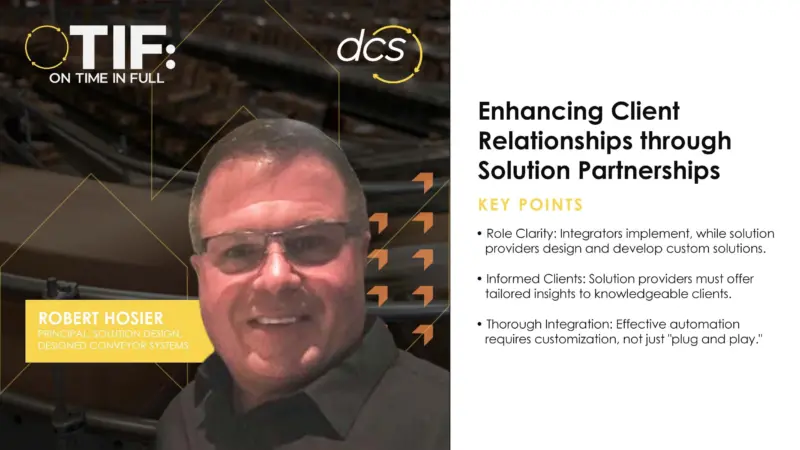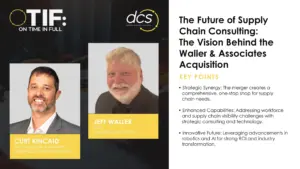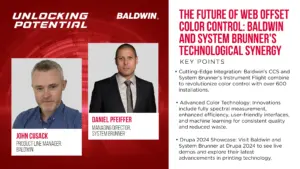Listen: Navigating The Endless Aisle With Bryce Stuckenschneider
Where do AEC professionals go to find their products? You’d think a basic Google search or Pinterest board would do the trick, but with such a low barrier of entry, finding products means sifting through a jungle of unverified, counterintuitive product layouts. Your other option is dimly lit, boiler room-level libraries with physical product journals and samples. Though you get the tactile benefit, these libraries are typically outdated, and not even by a close margin. In this next podcast from the series How to Stay Connected and Relevant in the Digital Age of Design, Bryce Stuckenschneider and Daniel Litwin break down the overwhelming issue of “navigating the endless aisle,” and why having a streamlined hub for product information is not only beneficial but critical. We also hear from Jeff Carlson, founder of MyResourceLibrary.com, who’s aiming to solve that problem with one easy-to-access, comprehensive digital library. Carlson details his journey into the AEC industry and gives some tangible context to architects and designers’ frustration with the AEC product dilemma.
“So architects and designers are asked all the time to lay out beautiful spaces that engage their employees and just knowing a configuration of a desk or a chair is half the battle.” Stuckenschneider says, “you have to know the one that’s going to get the most longevity, comfort, performance, ergonomics, what have you, and there are more and more companies who are offering things like this today and so it’s just a lot more difficult to find them. And so we’re going to, I think, unpack a little bit about tips and tricks, some digital tools that are out there, some companies that I think are doing some really smart things and what the future looks like.” Stuckenschneider tailors his tips and tricks to focus on finding the right product as an AEC and contract furniture professional. Daniel and Bryce discuss the technological advances Stuckenschneider witnesses everyday in the AEC industry and how that is impacting how professionals find product. They are joined by Jeff Carlson, whose digital product inventory is one of the technological advances available to AEC professionals currently.
Why is it Important to find the Right Product?
Daniel Litwin: Okay. So we started with finding the right education. Now we’re diving into finding the right product. So how important is it in the AEC world to find that right product as a professional, making sure that you’re not just settling for what’s accessible but digging in?
Bryce Stuckenschneider: Yeah. Sure. So architects and designers are asked all the time to lay out beautiful spaces that engage their employees and just knowing a configuration of a desk or a chair is half the battle. You have to know the one that’s going to get the most longevity, comfort, performance, ergonomics, what have you, and there are

more and more companies who are offering things like this today and so it’s just a lot more difficult to find them. And so we’re going to, I think, unpack a little bit about tips and tricks, some digital tools that are out there, some companies that I think are doing some really smart things and what the future looks like.
DL: Definitely. So I mean, for the longest time, a lot of finding these products has been in a very physical space, flipping through books, and we’ll dive more into the literal libraries. But things have been pushing into the digital space and I feel to a degree you said it does become easier getting quick digital access with a Google search or a Pinterest board, but then you get into an oversaturation…
BS: Exactly. Yeah. So the barrier to entry is a lot lower. It’s way easier to get product in front of people, but it’s so much noisier because there’s so much more of it. And so it’s a catch 22. And we’ll talk about, “How do you filter some of the stuff down? How do you know? Do you just trust the big brands?” Well, how does an up-and-comer make their name in this space if they don’t have the ad spender, the kind of sway that some of these big brands have?”
How do you find the Right Product?
DL: Right. So talk to me a little bit about that relationship now. There are some companies that we are going to talk about that are helping to turn down that noise a bit. But as an architecture, engineering construction, an AEC professional living in the industry, what is it like trying to search for a product digitally? Walk me through you sit down at the computer and it’s like, “Okay, time to find this product.” How would you even go about doing it?
BS: It’s kind of like finding, I don’t know, everybody has that one friend that’s really good at Googling things. We’re all debating a topic like, “Oh, I know like two words,” and half of the last name of somebody who wrote this article six years ago and your buddy is like, “Oh, yeah, I found it.” Every architecture and design firm has a person like that too. These people used to be what was called the librarians. They literally staff a library. And while some of them still hold that title or still sit in a physical room like that, a lot of them have become this kind of ancillary specialist. They’re a walking rolodex of what’s out there and what’s available and their job really is to be this resource, four people in their office.
 So small and medium-sized firms have somebody like this where, yeah, anybody in the firm can pull up Google or some of these tools that we’re talking about to try and find product. But more often than that, they’re going to this person first to help source those products or at least guide them in the right direction.
So small and medium-sized firms have somebody like this where, yeah, anybody in the firm can pull up Google or some of these tools that we’re talking about to try and find product. But more often than that, they’re going to this person first to help source those products or at least guide them in the right direction.
Why hasn’t Technology been Utilized more in AEC?
DL: I just think it’s interesting that the AEC industry is a little behind on this because it’s not like AEC is a stranger to digital collaborative technology. I mean, there’s so much technology out there that’s making it easier for designers and architects to literally collaborate digitally on their designs and get things out there faster, more efficiently in a safer manner. And so it’s just interesting that the product search part of the process has taken longer to streamline.
BS: There’s maybe two side of this conversation and I talked about it in the article is there’s the technology around designing a space whether you’re using Revit and rich BIM content or if you’re using something that’s more of a visualization tool like a CET Designer. Those things I think are making quantum leaps in doing those programs. Five years ago, I remember people saying, “Keep an eye out for this. Keep an eye out for this.” And now they’re mainstream, now they’re ubiquitous. People know about it.
On the product side, it’s a little trickier and I kind of liking it to this. Why Amazon has got this endless aisle? And we all go there for lots and lots of things. How do we know to trust something if it’s not a named brand? Well, they’ve got millions and millions of reviews, verified reviews from things, that sort of thing doesn’t really exist for the AEC community. And I don’t know anybody who’s really moving in that direction yet, but there’s just not this sort of peer-to-peer trust building exercise like an Amazon delivers and now obviously many, many other sites as well.
a little trickier and I kind of liking it to this. Why Amazon has got this endless aisle? And we all go there for lots and lots of things. How do we know to trust something if it’s not a named brand? Well, they’ve got millions and millions of reviews, verified reviews from things, that sort of thing doesn’t really exist for the AEC community. And I don’t know anybody who’s really moving in that direction yet, but there’s just not this sort of peer-to-peer trust building exercise like an Amazon delivers and now obviously many, many other sites as well.
DL: I mean do you think that that is what the industry needs to get to, to a point where you do see a four-star review on something?
BS: It had to be nice as long as it’s trustworthy, right? Because everyone has also seen the articles about people spamming Amazon. You can pay for Amazon comments and reviews and things like that.
“So feedback is great as long as it’s real and true. So the industry would have to find a way to do that, but I think there are smart people thinking about the same things we’re talking about today and I’m excited to see how the technology continues to advance the industry forward.”
Why are Companies like Jeff Carlson’s so Important?
DL: Definitely. So I’m excited to get our guest on the line here and dive into a bit more of some first-hand experience of taking that physical information, the book bound info of what products are out there and bringing it to the digital space and doing it in streamline and seamless way. I’m excited to dive into more of that. Could you tell us a bit about the guest that’s coming on the podcast today?
BS: Sure. So we’re going to talk to Jeff Carlson and I’ve known Jeff for six or seven years now and he is the founder of a company that I think is doing some really cool stuff. They took this idea of an old-fashioned physical library in architecture and design firms and furniture dealerships around the country and they said there’s got to be a better way to do this.  And so him and a partner set out to create a digital version of this. And I’ll let him tell the story when he gets on, but I’ve been on the other side. I was a customer of Jeff’s for a while and I was telling somebody today. It was some of the easiest money I ever spent being on the sales and marketing side of a manufacturer is I know that this service is getting our products in front of the right eyeballs way more cost effectively than hiring another salesperson and sending him and her out on the road.
And so him and a partner set out to create a digital version of this. And I’ll let him tell the story when he gets on, but I’ve been on the other side. I was a customer of Jeff’s for a while and I was telling somebody today. It was some of the easiest money I ever spent being on the sales and marketing side of a manufacturer is I know that this service is getting our products in front of the right eyeballs way more cost effectively than hiring another salesperson and sending him and her out on the road.
Daniel Litwin: Okay. So we are bringing you on Jeff because today’s whole topic is focusing around finding the right product as an AEC and contract furniture professional. So I just want to gauge from you, since you are in the space consistently every day, how frustrated are AEC and contract furniture professionals with sort of a lack of digital product inventory or sort of an ease of access for finding the right products for every right job?
Jeff Carlson: I think they’re really frustrated. I think that for years everybody wanted to build paper list. They all want to support the green movement, but they have yet to really find a site that actually meets and kind of does everything for them in that regard. So I think they’re frustrated with the outdated information that’s out there. I think they’re frustrated with every manufacturer’s website being different and really having to relearn pretty much everything as they go from site to site to try and get the information that they need for projects.
Bryce Stuckenschneider: So would you say it’s safe to assume that that headache, that refrain is something that you heard, Jeff, and that’s why you started MRL? I mean maybe this is a great jumping off point for you to explain even what your company does.
JC: Oh, yeah. Absolutely. So basically the reason My Resource Library got started is I was working as a national sales manager and I was out at the design firm. At that point, I have been logging binders and empty suitcases or full suitcases full of binders to all of these design firms across the country that I was calling on. A design firm told me that they no longer use binders and that they went to an Excel Spreadsheet to try and track manufacturers. I clearly thought there was no way that was going to work. I am third generation. My family started a rep group in 1952. My dad still runs a rep group. My older brother is a rep and my wife is an independent rep. So I’ve been able to see the transition go through, actually I was an independent rep as well. So we kind of created My Resource Library as kind of a visual because everybody in the AEC world wants visual, wants tactual, and so we created My Resource Library to be the visual aspect of the contract furniture library.
How Jeff has seen his Product Change the way People do Business
JC: I was at a dealership in Cincinnati, Ohio and the design manager informed me that they love their library, that their library is up-to-date, it’s current, they absolutely love their library. And I asked her the question because they signed up under our pro version and I asked them the question that if I could go in to their library, that she is so proud of, and if I could find six manufacturers that were outdated binders in their library, would she actually get rid of the physical library and go to My Library, which is way more up to date and current? Together, her and I went into the library. She actually went into My Resource Library.  I went in to her binders. I picked six binders up off the shelf and each of those binders have either outdated pricing or were missing products from the binder. She immediately said she conceded after six in a row and she get away with her library and now they have a TV that’s in where their library used to be with a computer on it and that’s where My Resource Library is housed.
I went in to her binders. I picked six binders up off the shelf and each of those binders have either outdated pricing or were missing products from the binder. She immediately said she conceded after six in a row and she get away with her library and now they have a TV that’s in where their library used to be with a computer on it and that’s where My Resource Library is housed.
DL: And that’s what I love to hear is when you challenge the preconceived notions and people see the literal benefit of having something not only digitized but digitized well and in a really easy to access manner, it’s almost full proof. There’s no reason not to transition. And so I hope that soon, the entire AEC industry sees something like My Resource Library as the standard, right? And that physical libraries aren’t even a question anymore. When do you see that happening? When do you see physical libraries and Google searches and Pinterest boards being a thing of the past and everyone really accessing websites like yours just from the beginning?
JC: Well, I think it requires the tools and I think that that’s one of the things that we’ve been working on is it has to be more than just a library. Yes, we started as a library, but it has to be more. It has to be interconnected with software. So we’re working with trying to get a hold of Revit, AutoCAD, CET Designer, and ProjectMatrix. All of those can integrate with inside of My Resource Library where you can just drag and put the information into their drawings. The other thing that we’re working on is the ability to literally order a memo sample, something as simple as ordering a memo sample in this day and age, even with digital, you have to go website to website, you have to fill out all the different forms. We’ve written a custom API that will go in of user can use My Resource Library and select the finishes that they want and click one button to order all of those samples. And that’s where we’re headed is we have to make it so efficient for them that there’s no reason for them to go to Pinterest or to go to Google or to go anywhere else where they’re getting information that’s maybe not updated.
BS: Right. And is it safe to say that’s the goal, right? MRL wants to be that hub that furniture and interior design professionals go to. This is where I go to get product information. This is where I go to get industry news. This is where I go to get my 3D symbols, where I go to get continuing education. I mean, you name it, you kind of want to be the fulcrum or the hub of everything that’s going on. Is that fair?
JC: That is more than fair. That is exactly what we’re working towards. That’s why my wife and kids never see me. I’m always on the road traveling. But we’re always spreading the word and we spread the word literally when I go in and meet with the new client, they are just amazed. They don’t even know where to start. There’s so much opportunity inside of My Resource Library that they get really excited and they’re ready to get rid of their library tomorrow, but it takes that initial step and then once they see it, they are ready move on it.
Read Bryce’s article detailing how to navigate the endless aisle.
For the latest news, videos, and podcasts in the AEC Industry, be sure to subscribe to our industry publication.
Follow us on social media for the latest updates in B2B!
Twitter – @AECMKSL
Facebook – facebook.com/marketscale
LinkedIn – linkedin.com/company/marketscale







